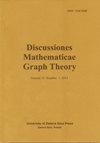3-网格上的邻接引导渗流
IF 0.8
4区 数学
Q3 MATHEMATICS
引用次数: 0
摘要
给定一个图 $G$,假设 $G$ 的一些顶点被感染,如果 $v$ 有至少 $r$ 被感染的邻居,则 $r$ 邻居引导渗滤规则会使未感染的顶点 $v$ 被感染。$G$的$r$渗滤数$m(G, r)$是$G$中初始受感染顶点集合的最小心数,即在连续执行$r$-邻居引导渗滤规则后,$G$的每个顶点最终都会被感染。在本文中,我们考虑的是具有固定宽度的网格的 $3$-自举渗滤数。如果 $G$ 是两条阶数~$3$和 $m$ 的路径的卡方积 $P_3 \square P_m$,我们证明当 $m$ 是奇数时,$m(G,3)=\frac{3}{2}(m+1)-1$;当 $m$ 是偶数时,$m(G,3)=\frac{3}{2}m +1$。此外,如果 $G$ 是车积 $P_5 \square P_m$,我们证明当 $m$ 是奇数时,$m(G,3)=2m+2$;当 $m$ 是偶数时,$m(G,3)=2m+3$。如果 $G$ 是车积 $P_4 \square P_m$,我们证明 $m(G,3)$ 取两个可能值中的一个,即 $m(G,3) = \lfloor \frac{5(m+1)}{3}.\rfloor + 1$ 或 $m(G,3) = \lfloor \frac{5(m+1)}{3}\rfloor + 2$.本文章由计算机程序翻译,如有差异,请以英文原文为准。
3-Neighbor bootstrap percolation on grids
Given a graph $G$ and assuming that some vertices of $G$ are infected, the $r$-neighbor bootstrap percolation rule makes an uninfected vertex $v$ infected if $v$ has at least $r$ infected neighbors. The $r$-percolation number, $m(G, r)$, of $G$ is the minimum cardinality of a set of initially infected vertices in $G$ such that after continuously performing the $r$-neighbor bootstrap percolation rule each vertex of $G$ eventually becomes infected. In this paper, we consider the $3$-bootstrap percolation number of grids with fixed widths. If $G$ is the cartesian product $P_3 \square P_m$ of two paths of orders~$3$ and $m$, we prove that $m(G,3)=\frac{3}{2}(m+1)-1$, when $m$ is odd, and $m(G,3)=\frac{3}{2}m +1$, when $m$ is even. Moreover if $G$ is the cartesian product $P_5 \square P_m$, we prove that $m(G,3)=2m+2$, when $m$ is odd, and $m(G,3)=2m+3$, when $m$ is even. If $G$ is the cartesian product $P_4 \square P_m$, we prove that $m(G,3)$ takes on one of two possible values, namely $m(G,3) = \lfloor \frac{5(m+1)}{3} \rfloor + 1$ or $m(G,3) = \lfloor \frac{5(m+1)}{3} \rfloor + 2$.
求助全文
通过发布文献求助,成功后即可免费获取论文全文。
去求助
来源期刊

Discussiones Mathematicae Graph Theory
MATHEMATICS-
CiteScore
2.20
自引率
0.00%
发文量
22
审稿时长
53 weeks
期刊介绍:
The Discussiones Mathematicae Graph Theory publishes high-quality refereed original papers. Occasionally, very authoritative expository survey articles and notes of exceptional value can be published. The journal is mainly devoted to the following topics in Graph Theory: colourings, partitions (general colourings), hereditary properties, independence and domination, structures in graphs (sets, paths, cycles, etc.), local properties, products of graphs as well as graph algorithms related to these topics.
 求助内容:
求助内容: 应助结果提醒方式:
应助结果提醒方式:


